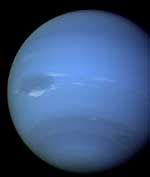
Image credit: NASA
Researchers from the Southwest Research Institute believe they have a theory that could help explain why there are so few objects in the Kuiper belt – a band of objects outside the orbit of Neptune. According to theories of how planetary systems form, there should be 100 times more material in the Kuiper belt than astronomers have observed. The researchers believe that the gas giants, including Neptune, formed closer to the Sun, and have slowly drifted further out over time. As Neptune migrated out, it could have pushed the Kuiper objects out of the solar system.
A new study by researchers at Southwest Research Institute (SwRI) and the Observatoire de la C?te d’Azur provides an explanation for one of the more mysterious aspects of the population of objects beyond Neptune. In doing so, it provides a unique glimpse into the proto-planetary disk from which the Solar System’s planets formed. Results will be published in the November 27 issue of Nature.
The Kuiper belt is a region of the Solar System that extends outward from Neptune’s orbit, containing billions of icy objects from kilometers to thousands of kilometers across. It was discovered in 1992 and, since that time nearly 1,000 objects have been cataloged. Some of these objects are very large – the largest having a diameter of more than 1,000 kilometers.
As astronomers have studied this structure, a mystery has unfolded. Like most of the planets in the Solar System, the large Kuiper belt objects are believed to have been formed from smaller objects that stuck together when they collided. For this process to have worked in the distant regions beyond Neptune, the Kuiper belt would have to contain more than 10 times the amount of material than is in the Earth. However, telescopic surveys of this region show that it currently contains roughly one-tenth the mass of the Earth, or less.
To solve the puzzle, researchers have been searching for several years for a way to remove more than 99 percent of the Kuiper belt’s material. However, Dr. Harold Levison (SwRI) and Dr. Alessandro Morbidelli (Observatoire de la C?te d’Azur of Nice, France) describe in their article, “Forming the Kuiper Belt by the Outerward Transport of Objects During Neptune’s Migration,” that the Kuiper belt may not have lost much mass at all.
“The mass depletion problem has been sticking in our throat for some time,” says Levison, a staff scientist in the SwRI Space Studies Department. “It looks like we may finally have a possible answer.”
Levison and Morbidelli argue that the proto-planetary disk from which the planets, asteroids and comets all formed had a heretofore unanticipated edge at the current location of Neptune, which is at 30 astronomical units (AU, the average distance between the Sun and Earth), and that the region now occupied by the Kuiper belt was empty. All the Kuiper belt objects we see beyond Neptune formed much closer to the Sun and were transported outward during the final stages of planet formation.
Researchers have known for 20 years that the orbits of the giant planets moved around as they formed. In particular, Uranus and Neptune formed closer to the Sun and migrated outward. Levison and Morbidelli show that Neptune could have pushed all the observed Kuiper belt objects outward as it migrated.
“We really didn’t solve the mass depletion problem, we circumvented it,” says Levison. “According to our work, the void beyond Neptune was probably devoid of objects.”
However, in this model, the region interior to 30 AU contained enough material for the Kuiper belt objects to form. The mechanisms employed by Neptune to push out the Kuiper belt only affected a small fraction of the objects. These became the objects seen by astronomers; the rest were scattered out of the Solar System by Neptune. This new theory explains many of the observable features of the outer Solar System, including the characteristics of the orbits of the Kuiper belt objects and the location of Neptune.
“One of the puzzling aspects of Neptune’s migration is why it stopped where it did,” says Morbidelli. “Our new model explains this as well. Neptune migrated until it hit the edge of the proto-planetary disk, at which point it abruptly stopped.”
NASA, the National Science Foundation and the Centre National de la Recherche Scientifique in Paris funded this research.
Original Source: SwRI News Release
